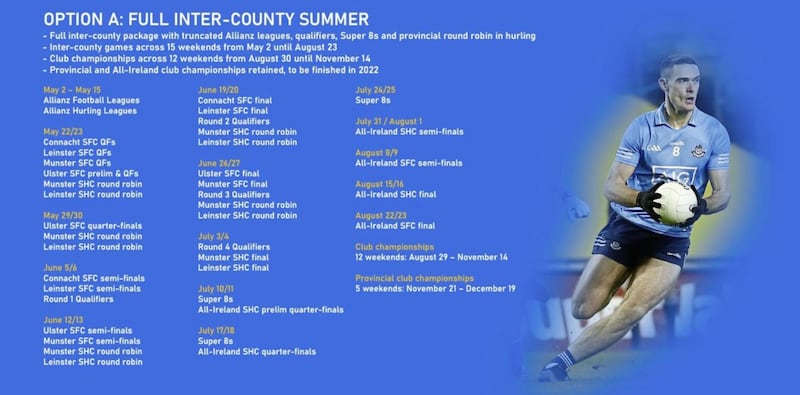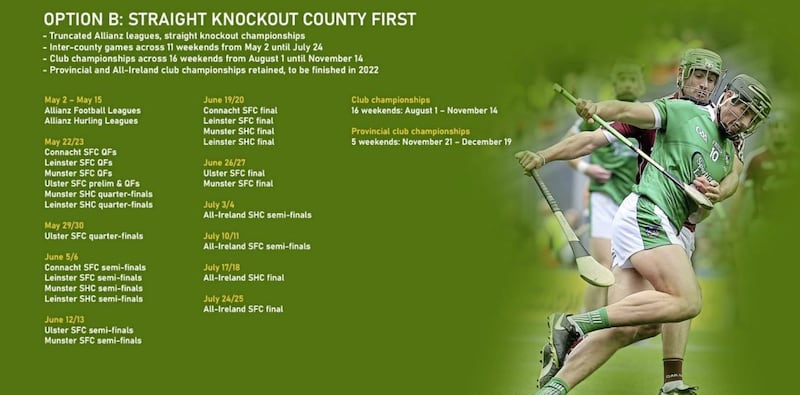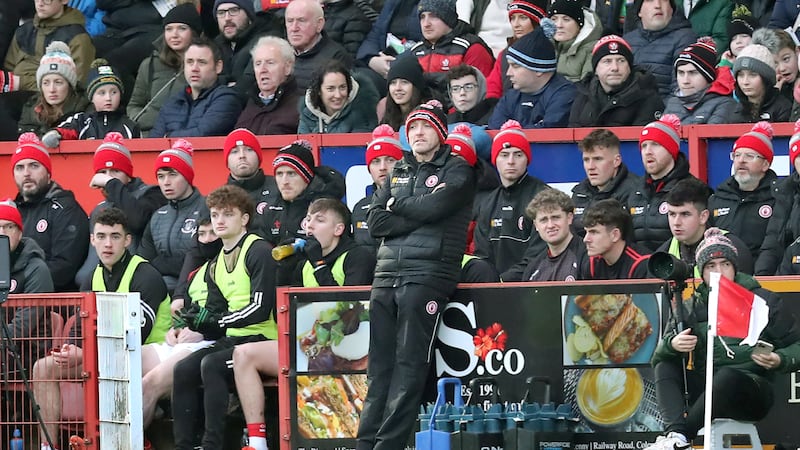OPTION A: FULL INTER-COUNTY SUMMER
IN terms of giving more games to inter-county teams and still retaining a sense of balance around the whole fixtures calendar, there is the potential for it to be done.
It would, however, be tight and put a significant strain on players from the beginning of May through to the middle of November.
That’s a shorter season than they’re used to in normal times, but the games would come at them more quickly and rest periods would be almost invisible.
The GAA would like, at some point, to finish the three-year trial on the Super 8s. This would be its final year. It does, however, appear to be a box-ticking exercise and not one that is seriously being considered as a long-term solution.
What it would offer to this year’s championship is the potential for big games among the better teams, and with the increased possibility of some spectators being allowed in to watch.
The likeliest timeframe for the Super 8s is from mid-July onwards, by which stage the GAA would be hopeful of being able to cover some of its astronomical financial losses through some much-needed gate receipts.
All in, the entire schedule does not seem completely unreasonable. There would be fewer rest periods than during a standard inter-county championship but to allow for the full package of qualifiers, Super 8s and provincial round robins in hurling, and have the All-Ireland finals finished in late August would appear acceptable to most.
All but eight counties in both codes would be finished up by July 4.
The Allianz Leagues look certain to be a sticking point no matter which direction the GAA takes, particularly in hurling.
Football’s competitions have already been abridged and three games can be squeezed in. But the two groups of six in hurling are more troublesome.
You think particularly of Antrim, who will want their Division 1B campaign to go ahead having worked so hard to earn it. Taking the top two leagues and splitting them into three groups of four, giving each team three games each, may be the way forward.
Otherwise, it is going to be impossible to run a full hurling schedule.
Clubs would have 12 designated weekends from August 29 through to mid-November in which to play championships. That would be tight for dual counties and there is more space available if inter-county schedules choose a different path, but it is doable for most in 12 weeks.
That would protect the provincial club championships, which would finish up the week before Christmas, with the All-Ireland series at the beginning of 2022, as the GAA is expecting to do.
To do that seems the preferable option in terms of continuity, but not in terms of weather. The majority of clubs would play most of their football in September and October, which is not far off how it’s been in recent years, but it isn’t ideal.
However, it would leave space for a league programme for clubs up until mid-September, government clearance permitting. If they were even allowed to begin by mid-June, there would be 10 weekends available before club championships start.
County players wouldn’t be available for those games but that is nothing new either.
The GAA appear to remain keen on inter-county games going first and will be keen to get as many of them played as possible. The idea of a full programme would be of great interest, but clubs may not be mad about waiting until the last weekend of August.

* * * * * * *
OPTION B: STRAIGHT KNOCKOUT COUNTY-FIRST
INTER-county games do look the most likely to go first but the way in which to do that and give as much of the year to clubs as possible is to operate off last year’s template.
The straight knockout championships in both codes threw up some brilliant storylines, especially the provincial footballing successes of Tipperary and Cavan.
It had its flaws too though, most notably evidenced by the combined 28-point margin of victory for Dublin and Mayo across the two semi-finals against the Munster and Ulster champions.
What it did do, though, was free up a lot of space in a calendar that needed to find it.
The same could happen this year.
Operating off the likelihood that games won’t begin until counties have had four weeks, so the first weekend of May, there would be the possibility once more of truncated Allianz Leagues, in which everyone gets three games.
It would be a straight hop then into knockout championship. The provincial championships would begin on May 22 and be finished up by the last weekend of June. Just four counties would remain and the club game would have all the air it needs.
The All-Ireland finals would be finished on July 18 (hurling) and July 25 (football). Presuming the All-Ireland club series’ stay in the new year, that would leave 16 weeks and plenty of good weather for clubs, who could begin championship on August 1.
If restrictions allowed truncated club leagues to get underway in June, there are possibly six weeks of games. Counties would also likely look, as they did last year, at round robin systems that would maximise the time and give everyone as many games as possible.
The chance of crowds attending inter-county games would be significantly reduced given the timeframe, and that is likely to be the biggest stumbling block to the schedule that seems to solve everyone’s problems best, barring the accountants.


OPTION C: CLUB-FIRST
THE least likely of the three options, the least workable of the three options, but would surely be the favoured option for club players across the land.
2020 brought a whole fresh sense of perspective to the game at club level, not to mention the enjoyment that was generated by playing games that you never thought would happen in weather you never thought you’d get to play in.
A hard surface and a dry ball goes a long way in the GAA, and the inter-county game has taken a monopoly of the summer in recent years.
Going club first in 2021 would hand the summer back to the clubs. Not only that, but it would increase the likelihood of crowds being able to attend inter-county games later in the year.
The upsides are obvious. Except the realities are that in order to play the club season to a finish, including the All-Ireland series’, there are a lot of variables.
The first and most significant is when exactly clubs will be allowed to play again. Inter-county games can begin in the south once they move to Level 4, but there is no set timeframe for moving to Level 3 which would allow club games to be played.
That would lead to great uncertainty and the potential squashing of the club window.
In order to give a space that would allow for a straight knockout inter-county championship to be played, the whole club year would need to be finished by October 3.
It means realistically, 13 weeks for club championships, which would need to be finished by August 15. That’s provided they’re allowed to start at the end of May which, at present, remains doubtful.
There is also the apparent danger of county teams interfering with club preparations. There have been instances of county teams breaching the current training ban and the reality is that the pressure on players to join county setups would be enormous as a potential late September start for Allianz Leagues comes into view.
The potential overlap of demand on players is a much greater issue when clubs go first. That said, having all county championships finished by August 15 would give two months before the inter-county championship begins, which should alleviate the issue somewhat.
If clubs go first, the inter-county game will have to be straight knockout. There’s no time left for anything else. That, however, may be of interest to the GAA if they thought having crowds at games was a possibility.
There would actually still be more room for the championship than was in 2020, with an additional two weekends in football. The Allianz Leagues would again have to be truncated in both football and hurling, to a maximum of three games each with no finals.








